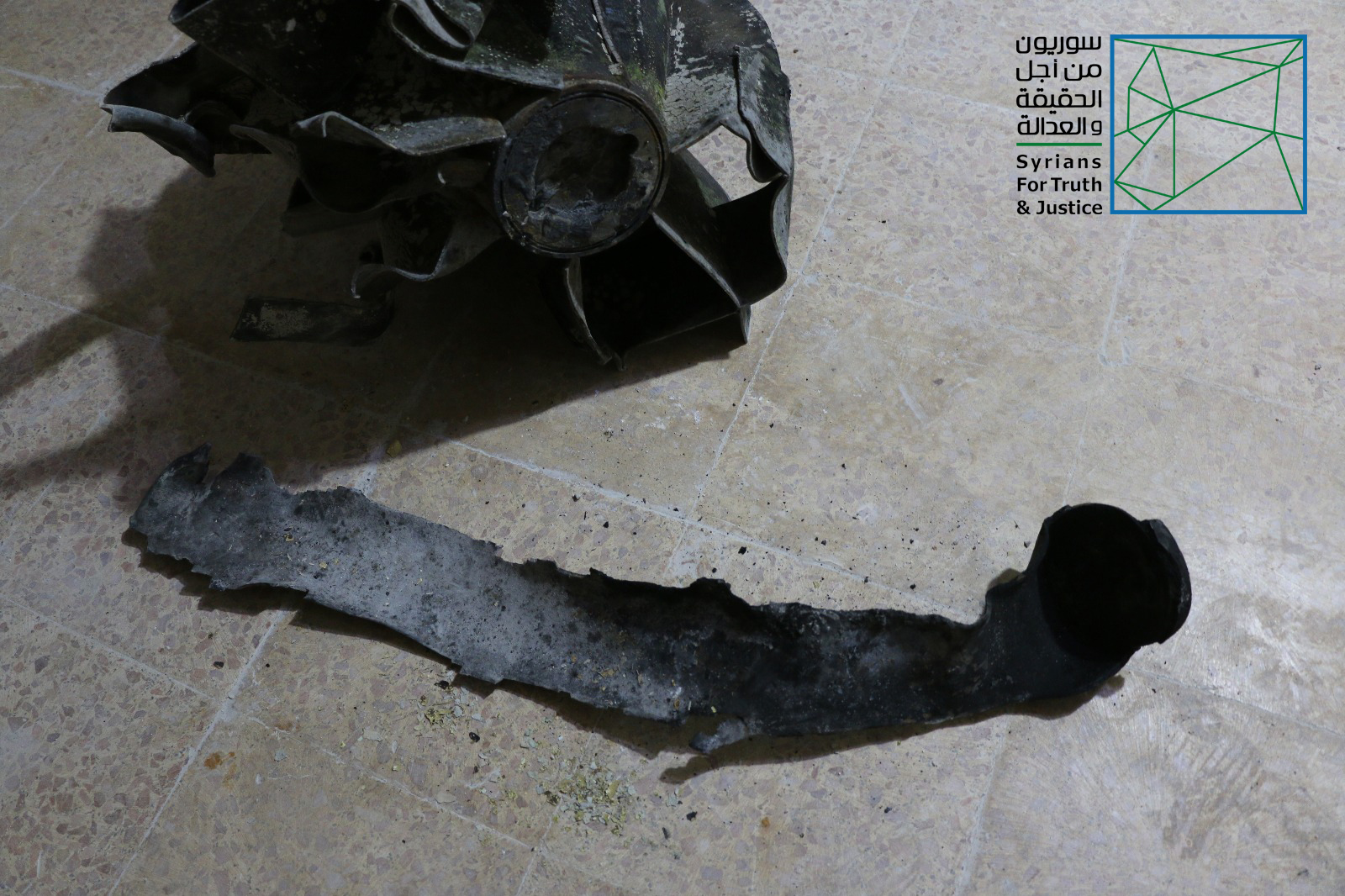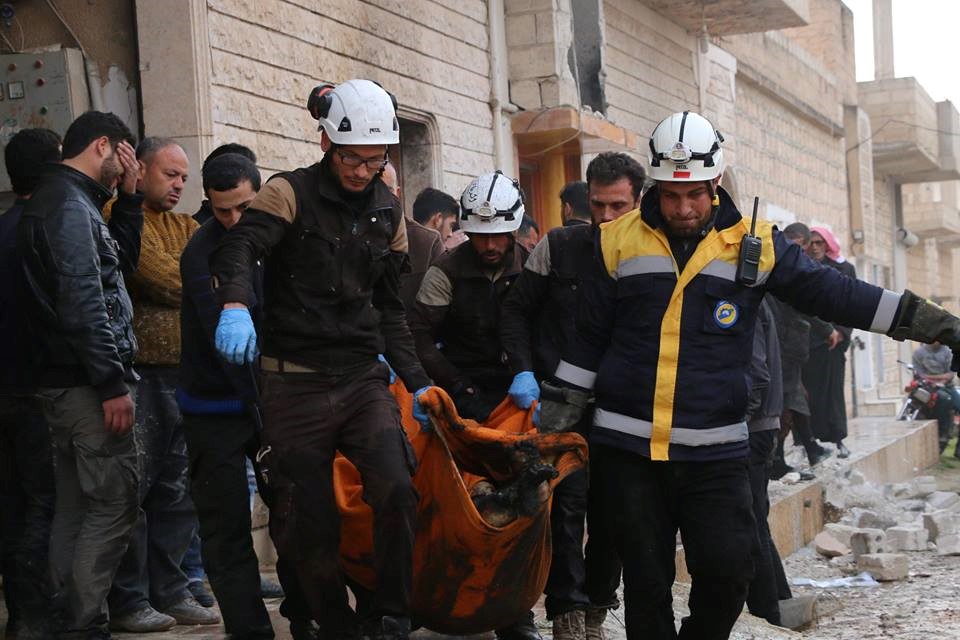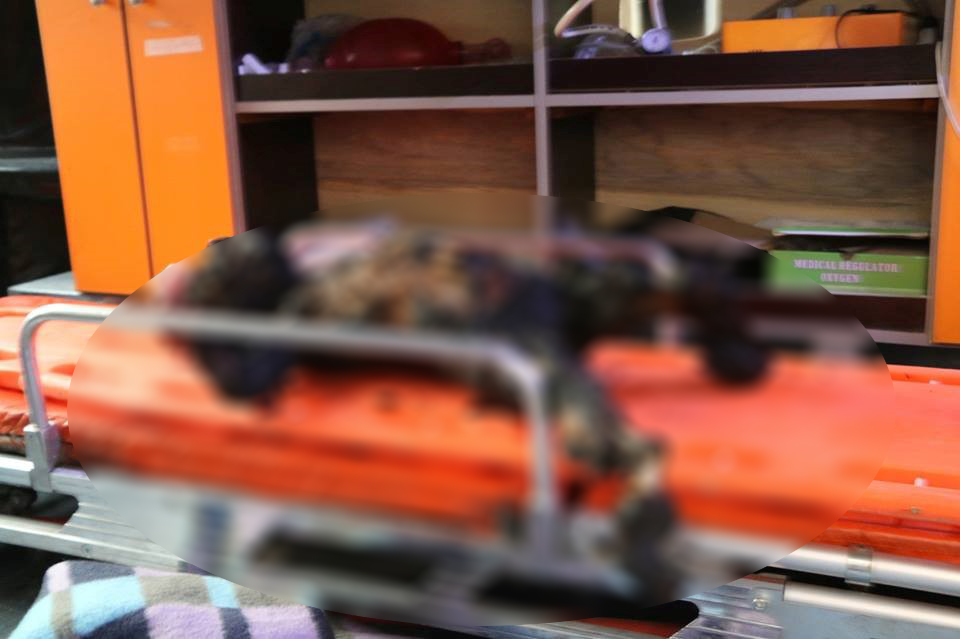Up to 10 civilians were killed and others injured as a result of shelling the eastern district in Khan Shaykhun in Idlib city countryside on Sunday December 17, 2017. According to many testimonies obtained by Syrians for Truth and Justice/STJ, specifically from observatories that monitor the movement of aircraft, the two warplanes that bombed the area were launched from the Hmeimim military base in Latakia province and are likely to be affiliated to Russian Air Force, as they carried out 10 raids on the city, including two raids targeting residential neighborhoods in the eastern district of the city. However, during the attack two rockets, one laden with napalm-like incendiary materials and the other loaded with cluster munitions, were dropped and left many victims among civilians, the majority were women and children.
The shelling coincided with the battles of Hayat Tahrir al-Sham/HTS, Nusra Front formerly[1], Jaish al-Izza Army/ the Army of Glory, Jaish al-Ahrar[2] and the Turkistan Islamic Party, in addition to the participation of other factions, including "Nour al-Din al-Zenki Movement[3]" and "Faylaq al-Sham[4] ", on one hand, against the Syrian regular forces and
its pro-militias on the other hand, in the northern Hama countryside, specifically since December 12, 2017. With a view to de-escalate both fronts of Idlib southern countryside and eastern countryside of Hama, which have been witnessing violent confrontations between the two sides since November 2017. However, HTS could control village of Zilaqiat and the gathering checkpoints of Zelin, before withdrawing from the gathering point–in the northern countryside of Hama– under Syrian regular forces control–which was the first line of clashes between HTS and Syrian regular forces. Anyway, HTS was able to seize some heavy machinery (the village Zilaqiat was controlled on December 17, 2017).
Abdul Salam Sarmini, from Khan Shaykhun who survived the shelling, but his seven-person family died, and in this regard he spoke to STJ saying:
"At 3:00 p.m., while I was out of the house to do some business, the warplanes targeted the eastern district of the city, where I live, and when I learned what happened, I rushed to my house to see my family, and I was shocked by ambulances and Civil Defense teams as they put out the fires and pulled the bodies from under rubble. All I can remember is that the fires had burnt my house, and when I searched for my family, I didn't find anyone inside, because they had been burned as a result of the shelling, and I could not identify the body of my wife or the bodies of my three nephews because they were burned and mutilated.

Image shows the remnants of a rocket loaded with cluster munitions, landed on the eastern district of Khan Shaykhun on December 17, 2017.
Photo credit: STJ

Image shows the remnants of a rocket loaded with napalm-like incendiary material that landed on the eastern district of Khan Shaykhun on December 17, 2017.
Photo credit: STJ
In another testimony, Hamid Qatini, a Civil Defense member in Khan Shaykhun, confirmed that warplanes, believed to be affiliated to the Russian Air Force, targeted the city by 10 air strikes on December 17, 2017. As warplanes carried out eight raids with vacuum rockets on the city, while the eastern district of Khan Shaykhun was bombed by two rockets, one laden with cluster munitions and the other with napalm-like incendiary materials, which left dozens of civilians victims dead and wounded.

Image shows the evacuation of the wounded and the removal of the bodies under the rubble, as a result of the bombardment of the eastern district of Khan Shaykhun on December 17, 2017.
Photo credit: the Facebook page of Civil Defense in Idlib province.

Image of a dead child burnt in the bombardment of the eastern district of Khan Shaykhun on December 17, 2017.
Photo credit: activists from the city.
One of the observatory supervisors of Khan Shaykhun, who is in charge of monitoring and controlling the movement of military aircraft in the city sky using special monitoring devices to get information then transferee it to the Civil Defense teams through radios, the supervisor spoke to STJ:
At 2:20 p.m., two Russian warplanes took off from the Hmeimim military base in Latakia and headed toward Khan Shaykhun, where they conducted the first missile strike on the outskirts of the city. Then they launched three air strikes on Harash area in the north of the city, followed by a raid on the western neighborhood of the city, and two raids on the International Highway prior carrying out double raids by rockets loaded with incendiary materials, believed to be napalm, in addition to cluster bombs, targeting the eastern district of the city, leaving 10 civilians dead, not to mention material damage and fires that broke out in the houses of civilians."
In turn, the Civil Defense teams in Idlib documented the names of civilians killed in the shelling that has affected the eastern district of Khan Shaykhun on December 17, 2017, including seven women and two children who had been burned, some of them identified as:
-
Ola Ghadban al-Sarmani/woman.
-
Tala Sarmani/ female child.
-
Nada Sarmani/female child.
-
Yazan Sarmani/ male child.
-
Fatima Najib Qatini/woman.
-
Shahad Mohammad Reda Qatini/woman.
-
Walaa Riad al-Sarmani/woman.
-
Fatima Riad al-Sarmani/woman.
-
Hala Ziad Idris Muhammad al-Sarmani’s wife /a woman
A video footage published by Civil Defense team on December 17, 2017, showed the fires that had broken out in civilian houses, as a result of targeting the eastern district of Khan Shaykhun by cluster munitions and napalm-like incendiary materials.
According to STJ reporter, HTS (Nusrah Front formerly) controls Khan Shaykhun since July 2017, after military confrontations erupted with Tahrir al-Sham al-Islamiyya Movement, which had already controlled the city. Anyway, Idlib province is a de-escalation area in Syria, as on May 4, 2017, the sponsored states of the Astana talks (Russia, Turkey and Iran ) signed a Memorandum of Understanding to establish the areas of de-escalation in Syria, which included the Eastern Ghouta in Damascus countryside , Idlib and parts of northern Homs province , as well as some parts of adjacent provinces(Latakia, Hama and Aleppo) and some parts of southern Syria. However, one of the most prominent items was the cessation of hostilities between conflicting parties and securing conditions for the delivery of medical assistance as well.
A special report on the chemical attack on Khan Shaykhon city, was issued earlier by STJ jointly with the Justice for Life Organization on April 4, 2017. STJ had previously issued a report documenting the use of cluster munitions in several areas in Eastern Ghouta during November 2017.
[1] On January 28, 2017, several jihadist factions in north Syria announced the merger under the name "Hayat Tahrir al-Sham/HTS " and the factions that announced the dissolution and the merger under the new name is Fatah Al-sham Front –former Nusra Front, the Nour al-Din al-Zenki Movement, Liwaa al-Haqq and the Ansar al-Din Front and Jaish al-Sunnah) However, against the backdrop of the recent outbreak of confrontations between Ahrar al-Sham al-Islamiyya Movement and HTS in the north on July 15, 2017, Nour al-Din al-Zenki announced its separation from HTS on July 20, 2017.
[2] Jaish al-Ahrar was formed in December 2016, with the support of the prominent military commander of the former "Ahrar al-Sham al-Islamiyya Movement", "Abu Saleh al-Tahan ", and its former general command of legitimacy, identified as "Abu Muhammad al-Sadiq". It included number of factions, most notably the "Liwa al-Tamkin " which controls the city of Binnish and its surroundings in Idlib countryside.
[3] Nour al-Din al-Zenki Movement was formed in late 2011, after the onset of armed actions in Aleppo province, it controls several towns in the northwest Aleppo countryside such as (Anjar, Taqad and Qabtan al-Jabal), with approximately 5,000 combatants. However, it participated in several battles against the Syrian regular forces in neighborhoods of Aleppo, it also contributed to the expulsion of ISIS from the city. There were many alliances and splits in the Movement course, as it had acceded to HTS on March 13, 2016, but because of HTS decision to fight Ahrar al-Sham al-Islamiyya Movement in the north of Syria on July 15, 2017, Nour al-Din al-Zenki Movement split from the ranks of HTS on July 20, 2017.
[4] Formed on March 10, 2014, it is one of the largest Syrian armed opposition factions, and one of the largest formations of the military opposition participated in Astana talks about Syria. It exists in several areas, including the southern and northern Idlib countryside, the western Aleppo countryside and the northern countryside of Homs.

